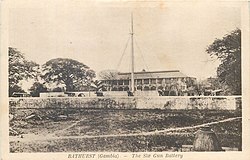Six-gun battery
| Kunta Kinteh Island and related sites (six cannon battery) | |
|---|---|
|
UNESCO world heritage |
|

|
|
| Six-cannon battery on a historic postcard |
|
| National territory: |
|
| Type: | Culture |
| Criteria : | (iii) (vi) |
| Surface: | 0.17 ha |
| Reference No .: | 761-002 |
| UNESCO region : | Africa |
| History of enrollment | |
| Enrollment: | 2003 (session 27) |
Six-gun battery (official name of the site as World Heritage: Six-gun battery ) was a battery at the mouth of the Gambia River at Banjul Point in today's capital Banjul . The site has been added to the UNESCO World Heritage List as Kunta Kinteh Island and related sites .
Location and access
The six-cannon battery is located at the northern end of Banjul (until 1973 Bathurst) at the mouth of the river on the south bank and was one of several batteries. The battery is located on the State House grounds on the riverside. The cannons are visible behind the fence when you pass the entrance to the State House. They are not open to the public and cannot be approached without special government approval.
history
The battery was completed by the British in 1821 in the newly built city of Bathurst, which was founded on St. Mary's Island - a sandbar - in 1816 . Fort Bullen in Barra and the six-gun battery in Banjul are the only known structures in West Africa that were built by Europeans to prevent the slave trade. Although the British government had banned the slave trade , unscrupulous traders were still operating. The Gambia River had been recognized as British possession by the Treaty of Versailles in 1783 , and the 1807 Abolition Act made slave traffic on the river illegal. The takeover of Bathurst from the ruler of Kombo, and soon afterwards the construction of a battery of six 24 pounder cannons , two fields on the banks and barracks for 80 soldiers, aimed to address this situation. The idea was that the battery could provide enough firepower to stop any ships attempting to sail out of the estuary and that their capture would then be done by naval vessels on patrol. Within months of setting up the base in Banjul, five slave ships were confiscated from the newcomers. However, it was soon discovered that the battery's firepower could not traverse the full width of the estuary, which at the time is about 8 miles wide. Ships could easily escape as they approach the north bank of the river. Fort Bullen was therefore built in 1827 on the north bank opposite the six-cannon battery to cover this escape route. The fort was built under the supervision of Commodore Charles Bullen , who was dispatched by the British government to consolidate the work to suppress the slave trade in The Gambia. With cannon batteries on either side of the estuary, the British finally had full control of all trade on the Gambia River.
The six-gun battery and Fort Bullen were abandoned in 1870.
description
The battery consisted of six 24-pounder cannons. The six cannons are installed on inclined rails fixed at an average height of 1 m. They are protected by a large parapet wall made of stones laid in lime mortar and plastered with lime sand mortar. Their arrangement enables a coverage angle of about 30 °.
For battery, the status of a national monument was submitted at the time of the application for UNESCO World Heritage. The Office of the President, the main actor, has supported the proclamation, which is now awaiting publication in the Chambers of the Attorney General (as of 2003). Once the site has been declared a National Monument, it will come under the jurisdiction of the National Center for Arts & Culture (NCAC). But the site certainly needs to be jointly managed with the President's office.
See also
Web links
- Entry on the UNESCO World Heritage Center website ( English and French ).
- National Center for Arts & Culture: Six-gun battery (English)
Coordinates: 13 ° 27 ′ 26 " N , 16 ° 34 ′ 26" W.
